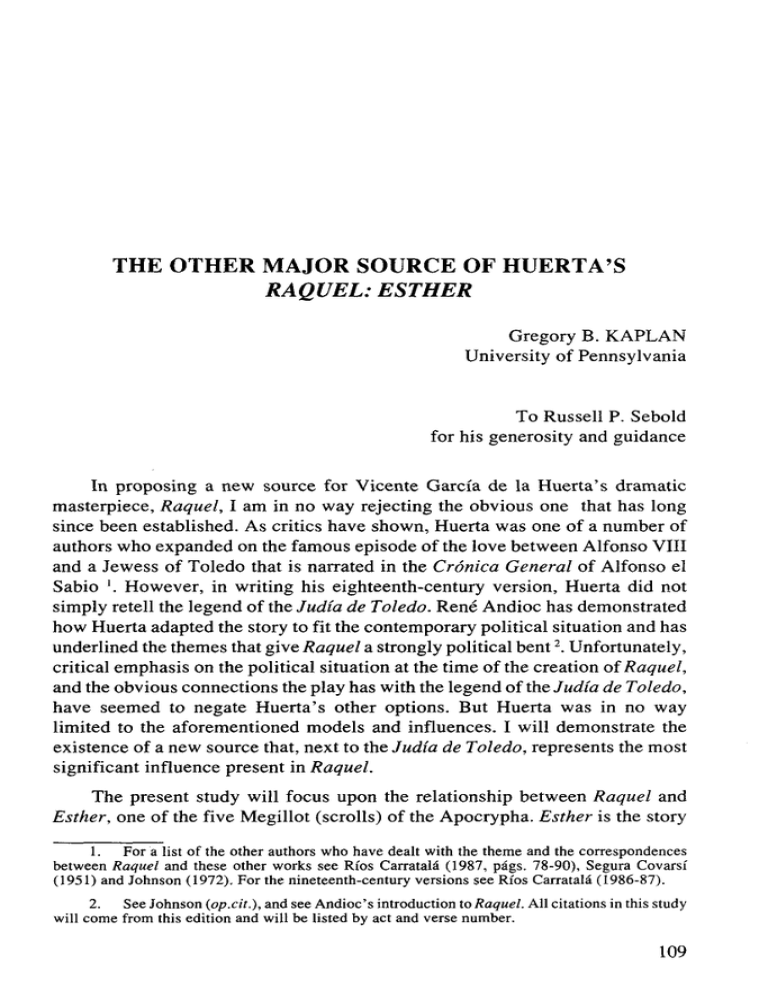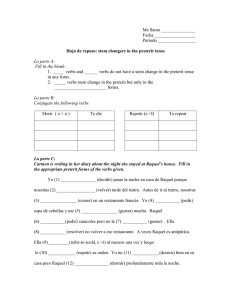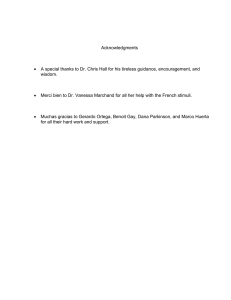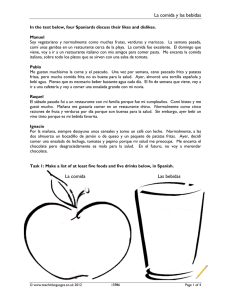the other major source of huerta`s raquel: esther
Anuncio

THE OTHER MAJOR SOURCE OF HUERTA'S RAQUEL: ESTHER Gregory B. KAPLAN University of Pennsylvania To Russell P. Sebold for hís generosity and guidance In proposing a new source for Vicente García de la Huerta's dramatic masterpiece, Raquel, I am in no way rejecting the obvious one that has long since been established. As critics have shown, Huerta was one of a number of authors who expanded on the famous episode of the love between Alfonso VIII and a Jewess of Toledo that is narrated in the Crónica General of Alfonso el Sabio '. However, in writing his eighteenth-century versión, Huerta did not simply retell the legend of the Judía de Toledo. Rene Andioc has demonstrated how Huerta adapted the story to fit the contemporary political situation and has underlined the themes that give Raquel a strongly political bent 2 . Unfortunately, critical emphasis on the political situation at the time of the creation of Raquel, and the obvious connections the play has with the legend of the Judía de Toledo, have seemed to negate Huerta's other options. But Huerta was in no way limited to the aforementioned models and influences. I will demónstrate the existence of a new source that, next to the Judía de Toledo, represents the most significant influence present in Raquel. The present study will focus upon the relationship between Raquel and Esther, one of the five Megillot (scrolls) of the Apocrypha. Esther is the story 1. For a list of the other authors who have dealt with the theme and the correspondences between Raquel and these other works see Ríos Carratalá (1987, págs. 78-90), Segura Covarsí (1951) and Johnson (1972). For the nineteenth-century versions see Ríos Carratalá (1986-87). 2. See Johnson (op.cit.), and see Andioc's introduction to Raquel. All citations in this study will come from this edition and will be Usted by act and verse number. 109 A.L.E.U.A. / 8 GREGORYB.KAPLAN of an attempt to massacre the Jewish people. This attempt is stopped only when Esther, a Jewess who has come to be queen of Persia, adheres to the advice of Mordecai, her únele and counselor, and intercedes by confronting King Ahasuerus. She eventually succeeds in thwarting the efforts of the man responsible for the threat, the villainous courtier Haman 3. Though the pervading theme is the imsuccessful attempt at eradicating the Jews, Esther is appealing for a variety of reasons such as its religious significance, the debate over its historicity and its merit as literature. According to Robert Gordis, "The Purim story has all the ingredients of an engrossing play" (1974, pág. 15). It is not therefore difficult to imagine that Huerta may have considered Esther a highly attractive source for his tragedy. The various similarities that exist between the plots of Esther and Raquel make for an interesting starting point when comparing the two works. In both stories the Jewish heroine receives important advice from her counselor, advice that will be crucial in determining the outeome of the story. In chapter four of Esther the Jewess, after having been named queen by Ahasuerus, is informed by Mordecai of Haman's plot to kill the Jews. Though she is well aware that she risks death by making an unauthorized appearance before the king she is advised by Mordecai to do so in order to intercede on behalf of her people. Esther heeds this advice and visits the king. It is then when she is able to begin to plan the eventual salvation of the Jews and the destruction of her enemy Haman. Only because she permits the advice to influence her is Esther able to foil her enemy's scheme. In other words, it is Mordecai's advice which serves as one of the focal points in determining how the plot changes course. We note a parallel in the role Rubén's advice plays in Raquel. Russell P. Sebold has underlined the importance of the heroine 's acceptance of the advice by identifying it as her "yerro disculpable" (1989, pág. 311). It is precisely because Raquel follows her counselor's advice, to get back royal favor for herself and for her people, that the plot takes a different direction leading to her murder. Although the threat against the Jews is much less emphasized in Raquel, Huerta's heroine, like Esther, sees herself thrust into a position by her advisor where she must appeal to the king, even resort to tears, in order to save her people: ¿Así remedias la ruina y eversión del Pueblo Hebreo? ¿Así Raquel, redimes las miserias de tu infeliz Nación? (2.1 -5) 3. All citations in this study will come from Gordis' edition of Esther which contains both the Hebrew text and an Enghish translation. The citations will be Usted by chapter and verse number. 110 The other major source of Huerta's Raquel: Esther A.L.E.U.A./8 Del indignado Alfonso en la presencia, las perlas que aquí viertes sin provecho de nuestra libertad rescate sean (2.32-34) In doing so she ultimately risks her own fate, as Esther did. If they do not follow their counselor's advice both heroines must resign themselves to play insignificant roles in the story. Esther will go on being a part of the king's harem and Raquel will be exiled. Yielding to the counselor's advice is the cause of happiness in Esther and tragedy in Raquel. We also see another similarity in the advice given to the heroines. In trying to convince Esther that she must act Mordecai states: "And who knows whether it was not for a time like this that you have attained to royal estáte?" (4.14). In other words Mordecai's message to Esther is that she should take advantage of the situation (the favor Ahasuerus has shown her) in order to reap the benefits (the salvation of the Jews). Rubén gives a similar message to Raquel. He tells her, "delirio es de tu amor tal pensamiento;/ recobra la esperanza, y aprovecha, si quieres remediar el mal presente" (2.107-09). Like Mordecai, Rubén wants Raquel to capitalize on an opportune moment. Both heroines must also hope that they continué to appeal to the king as they have in the past. Only then can they be successful. Before seeing the king each woman feels she has lost some of this appeal. Esther is not sure whether it is the right time to visit Ahasuerus because she has been all but fogotten at the court: All the king's servants and the people of the king's provinces know that for any man or woman who comes to the king to the inner court without an invitation, there is only one law —death— unless the king extends to him his golden scepter; only then he may live. As for me, I have not been called to come to the king these last thirty days. (4.11) Rather than being executed she receives a favorable greeting by a king who, out of love for his queen, is prepared to offer her whatever she wants: When the king saw Queen Esther standing in the courtyard, she won his favor...Then the king said to her, "What is troubling you, Queen Esther, and what is your petition? Be it half the kingdom, it will be granted to you!" (5.2-3) Similarly, Raquel finds it difficult to accept Rubén's position because she has been scorned by Alfonso: "Alfonso, el mismo Alfonso me condena;/ de su boca, Rubén, de mi destierro/ he escuchado yo mismo la sentencia" (2.56-58). Yet Raquel is equally successful in her appearance before the king when Alfonso gives her power to rule over his lands: "sabed que hoy en mi Trono 111 A.L.E.U.A./8 GREGORYB.KAPLAN substituyo/ a Raquel; mi poder y mi dominio/ la transfiero" (2.669-71). Neither woman finds as easy way out. In reality they have little choice but to accept the advice that is given. Mordecai warns Esther of the consequences of not acting: "For if you remain silent at this time, relief and deliverance will arise for the Jews from another quarter, but you and your father's house will be destroyed" (4.14). As Rubén relates, Raquel must intercede or disaster will result: El pacífico hogar, el quieto albergue edificados por las manos nuestras, quedarán de su dueño abandonados a injusto poseedor; y las riquezas que acumuló la industria y la fatiga, apagarán su avara sed apenas. (2.15-20) In both works we see three characters connected in such a way that they share the blame for what occurs. In Esther the king, queen, and counselor demónstrate this type of affiliation. Mordecai, as we have seen, is the one who advises Esther to approach the king. He is the one who incites her towards her destiny. Ahasuerus helps Esther reach her goal by not stopping her in her effort to terminate the plot against the Jews. Therefore, both male characters are essential in the development of the plot as the heroine's success depends in large part on their activity (or, in Ahasuerus' case, his inactivity). Donald E. Schurlknight has written that, "todos tres —Raquel, Alfonso, Rubén— son responsables de la tragedia" (1981, pág. 77). Just as Mordecai's advice pushes Esther into her role as savior of the Jews, Rubén is responsible for the tragic situation into which Raquel falls as he teller her: "Estas son las funestas consecuencias,/ que por más que esforzaba el artificio,/ temí de mi ambición y tu soberbia" (3.396-98). Of course, the significant difference is that while Esther is able to save her life, Raquel is not so fortúnate. Alfonso is like Ahasuerus in that he is directly responsible for the final consequences because he gives in to Raquel's request. While it is true that Esther benefits, and Raquel suffers, the act of giving in makes each king an unknowing participant. In Act Three, upon lamenting the death of Raquel, Alfonso says: "Yo tu muerte he causado, Raquel mía" (775). By conceding, Ahasuerus has saved Esther's life, while Alfonso's similar act has ended the life of Raquel. However, in both cases conceding to the wishes of the heroine has played an extremely significant role in the story. In Esther, Haman is responsible for bringing on his own downfall. Even after Esther has exposed Haman's plot to Ahasuerus, it is not until the villain incriminates himself that his fate is sealed. Ahasuerus decides that Haman must die, not because he has been informed of his plot against the Jews, but because 112 The other major source of Huertas Raquel: Esther A.L.E.U.A./8 he finds Haman in a compromising position with the queen (Chap. 7). Actually, the King encounters Haman while he is begging forgiveness of Esther and interprets Haman's actions as being amorous advances towards the queen. Unfortunately for Haman, he has trapped himself and will soon meet with death. Until now we have focused on the parallel between Rubén and Mordecai and their role as counselors. Of course, this resemblance ends when we consider their overall roles in the play. Mordecai is virtuous while Rubén is always viewed as being the most villainous character in Raquel. Therefore, in a comparison of Esther and Raquel, it is fitting that the most wicked character in each work meets his fate in a similar manner, and therefore we must now compare Haman and Rubén. Rubén is not killed by the citizens or the noblemen when his wickedness is exposed. Rather he, like Haman, incriminates himself when he kills Raquel. He does so because Alfonso enters and wrongly assesses the situation. Just as Ahasuerus does not realize that Haman is only trying to save himself by speaking with Esther, Alfonso does not truly know why Rubén has killed Raquel. Although his action certainly demonstrates his disloyalty, it is nonetheless true that the only way in which Rubén can save himself is to kill Raquel: "Pues si no hay medio,/ conserve yo mi vida, y Raquel muera" (3.673-74). Rubén shares a common motive with Haman, the motive of self-preservation, which leads to tragedy in both cases when the king acts, albeit rightly, without knowing all the facts. Having reviewed the plot similarities between Esther and Raquel let us examine the similarities between the characters of the two works. This will lend additional credence to the theory that Esther was one of Huerta' s two major sources. We will focus on the parallels between Esther and Raquel and those between King Alfonso and King Ahasuerus. Aside from being the heroines of their respective stories Esther and Raquel share various qualities. First, they are motivated to act for similar reasons. Esther risks her life because she must come to the aid of her people. She does not become queen because she wants to save the Jews; rather she is obligated to do so after learning of Haman's plot from Mordecai. As we have seen, she approaches Ahasuerus, not out of any personal interest but because she realizes her people are in danger. In Raquel, the heroine is also inspired to aid the Jewish people: "¿Y los Hebreos/ que no tienen, Señor, otro delito/ que depender de mí?" (2.643-45). Though she is also motivated by her love for Alfonso, the motivation to save the Jews certainly plays a role, as Monroe A. Hafter has noted: "Rubén speaks movingly of the suffering of their countrymen, and urges Raquel to exploit the advantages offered by Alfonso's strong love for her" (1985, pág. 222). 113 A.L.E.U.A. / 8 GREGORY B. KAPLAN Another very interesting comparison comes to light when we consider that both heroines come to occupy a high royal office without having been born into the nobility. In his introduction to Esther, Robert Gordis explains that because Esther lived in Persia she had absolutely no right to become queen because "Persian queens had to come from one of seven noble Persian families" (1974, pág. 8). The only reason Esther becomes queen is because of Ahasuerus' instant attraction for her: the king loved Esther more than all the other women, for she won his favor and kindnes more than all the other virgins. So he placed the royal crown upon her head and made her queen instead of Vashti. (2.17) Raquel, though not a member of the nobility, is also bestowed with royal powers when she receives Alfonso 's crown and scepter. Like Esther she is elevated to this position because of Alfonso's overwhelming love for her: Y porque tu temor desvanecido del todo quede; porque no receles de un vulgo osado los infieles tiros, desde hoy de mi Cetro y mi Corona serás dueño absoluto. Mis dominios a tu arbitrio se rijan y gobiernen. (2.646-51) Juan A. Ríos Carratalá has attempted to de-emphasize Raquel's qualities as a heroine and has given Hernán García the principie role in the tragedy (1987, págs. 99-100). However, Professor Sebold has clearly demonstrated how Huerta was making a comment on the contemporary concept of nobility when he caused Raquel to say: "la virtud solamente es la nobleza" (3.320). According to Sebold, Raquel is a true tragic heroine because she is a result of the "perenne adaptabilidad de las formas clásicas" (1989, pág. 312). In his effort to criticize the nobility, Huerta could easily have turned to Esther as a model of a virtuous woman who, in rising from the common class to become queen, demonstrates valor by risking her life to save her people. A strong parallel may also be found btween King Ahasuerus and King Alfonso. In Esther Ahasuerus is a man who is conspicuously uninvolved when important decisions are made and permits events to proceed without intervening. Haman is able to conceive the eventual massacre of the Jews by convincing Ahasuerus that the Jews are a threat and by obtaining the royal seal to issue his decrees (Chap. 3). The story continúes in Haman's favor until Esther is able to appeal to the king's emotions and persuade him to hold two banquets, which is part of her plan to trap Haman (Chaps. 5-6). Ahasuerus never realizes what is going on and acts like a secondary character when major events occur. Ahasuerus is a weak character, but this weakness is essential to the plot because if he were stronger and did not let Esther appeal to his emotions, the heroine would never 114 The other major source ofHuerta's Raquel: Esther A.L.E.U.A. / 8 have met with success. Overall, Ahasuerus remains in the background serving more as a symbol of a monarch rather than as the ruler of an empire. At times he has even been taken for a fool (Berg, 1979, pág. 63). His character is certainly a far cry from the monarch he is supposed to represent, the great Persian King Khshayarsha (known by the Greeks as Xerxes) (Gordis, 1974, pág. 5). Alfonso is equally weak. He is unaware of the plot against Raquel and leaves for a hunting trip when the situation comes to a boiling point. The play continúes whithout him until he walks in after it is too late. It is interesting to note that in creating Alfonso as a weak character Huerta departed from one of the other versions of the Judía de Toledo, Luis de Ulloa's poem Raquel. According to Ríos Carratalá: En la obra de Huerta el monarca, sumido en su función simbólica, cambia muy superficialmente de actitud con respecto a su amada, sin mostrarnos la más mínima profundidad psicológica. Pero en Ulloa Alfonso VIII sufre intensamente ante la presión de elementos tan contradictorios. (1987, págs. 83-84) Alfonso's weakness, like that of Ahasuerus, has an important function in the story. If he had not given in to Raquel, and conferred upon her the power to be queen, she would probably not infuriate the noblemen to the point where they are ready to murder her. Like Ahasuerus, the Alfonso of Raquel is a shadow of his historical counterpart, who was "once the heroic victor of Las Navas de Tolosa and other campaigns" (Hafter, 1985, pág. 119). Rene Andioc has defined Alfonso 's reign in Raquel as one which "excluye toda referencia a leyes fundamentales, tiene como único motor las pasiones que esclavizan al que gobierna —pasiones simbolizadas en este caso por el dominio de Raquel sobre su real amante—" (1975, pág. 131). This reminds us very much of Ahasuerus' reign, in which the fate of an entire people depends on the influence Esther is able to exert over him. Both monarchs are ultimately ruled by their profound love for women who have acquired the power to reign over their respective kingdoms. There is certainly much evidence to support the theory that Huerta was influenced by Esther. However, even if he was not directly familiar with the biblical text Huerta would still have had various opportunities to learn of the story because "el tema de la reina Ester se ha tratado en numerosas ocasiones a lo largo de nuestra historia [española]" (Bolaños Donoso, 1983, pág. 290) 4 . The Esther theme was introduced into Spanish literature in 1576 when the Auto de Mardoqueo was staged in the colegio de los Jesuitas de Gran Canarias. The story was retold by the Golden-Age dramatist Lope de Vega in 1610 when he wrote La hermosa Ester. 4. For an analysis of the Esther tradition in Spanish Literature see Bolaños Donoso (1983, págs. 290-94). 115 A.L.E.U.A./8 GREGORY B. KAPLAN In 1613 Felipe Godínez wrote La reina Ester. He later wrote a similar play called Aman y Mardoqueo (which is also known as La horca para su dueño). In 1627 Joan Pinto Delgado wrote a poem called Reina Ester. The tradition was continued by others, including Racine, in his Esther (1689), with which Huerta may well have been acquainted, as well as by Juan Climaco Salazar with his poem Mardoqueo in 1791; and the theme was utilized several more times in the nineteenth century (Bolaños Donoso, 1983, págs. 290-94). It is intriguing to consider the direct influence these works may have had on Huerta. But is also important to note that they do not distort any of the important aspects of the original story that is interpreted in Huertas's work. In any case, we can draw a distinct parallel between the Esther theme, as it is represented in the Golden Age, and Raquel. In the Oíd Testament, the story continúes after the death of Haman to include descriptions of how Mordecai rose to occupy Haman's oíd position and how the Jewish festival of Purim was subsequently established in order to commemorate the failure of Haman's plot (Chaps. 9-10). However, Lope and Godínez omitted these final chapters and, instead, finish with the scene in which Haman is killed (Bolaños Donoso, 1983, pág. 293). In this respect Huerta's play, in whose last scene Rubén and Raquel are killed, reminds us of the Esther works that end with the death of the most villainous character. In addition, in her analysis of Godínez' Aman y Mardoqueo, Piedad Bolaños Donoso demónstrales how the work contains an alternating emphasis on amorous and political themes, with Act Three being dedicated almost entirely to political matters (1983, pág. 285-86). This emphasis on the political may have served as a model to Huerta when he decided to incorpórate current eighteenth-century political themes into Raquel. I can suggest one more important proof of Huerta's knowledge of the Esther story. In his Teatro Español (1785), Huerta lists Lope's play, La hermosa Ester, and was also aware of both of the works Godínez had written (Vega García-Luengos, 1986, pág. 74) 5 . Therefore, we are certain that Huerta was directly familiar with the theme, a fact which lends a great deal of credence to the theory that the Esther story was one of his main sources. The evidence we have uncovered has afforded us the opportunity to draw a new conclusión concerning the sources of Raquel. In designing the story of his tragedy Huerta relied upon other works that had dealt with the legend of the Judía de Toledo. After the Judía de Toledo, as the striking parallels between Raquel and Esther prove, Esther was Huerta's next most important source. Raquel is at one and the same time a continuation of the Esther tradition and the Spanish tradition announced in Huerta's title. 5. (1986). 116 For more detailed explanations of what Huerta knew of Godínez see Vega García-Luengos The olher major source ofHuerta's Raquel: Esther A.L.E.U.A. / 8 WORKS CITED ANDIOC, Rene. 1975. "LaRaquel de Huerta y la censura", Híspame Review, 43, págs. 115-139. — (ed.) 1987. Introduction and notes. Raquel, Madrid, Castalia. BERG, Sandra Beth. 1979. The Book of Esther: Motifs. Themes andStructure, Missoula, Scholars. BOLAÑOS DONOSO, Piedad. 1983. La obra dramática de Felipe Godínez (trayectoria de un dramaturgo marginado). Sevilla, Excma. Diputación Provincial. GORDIS, Robert. 1974. Introduction, translation and commentary. MegillatEsther, New York, Ktav. HAFTER, Monroe Z. 1985. "Remedial Action in Huerta's Raquel". Studies in Honor of Sumner M. Greenfield. Ed. H. L. BOUDREAU and Luis T. GONZÁLEZ DEL VALLE, Lincoln, Society of Spanish and Spanish-American Studies. JOHNSON, Jerry L. 1972. The Relevancy of La Raquel to its Times", Romance Notes, 14, págs. 86-91. RÍOS CARRATALÁ, Juan A. 1986-87. "Versiones decimonónicas de la leyenda de la Judía de Toledo", Anales de Literatura Española, 5, págs. 425-36. —. 1987. Vicente García de la Huerta (1734-1787), Badajoz, Aprosuba. SCHURLKNIGHT, Donald E. 1981. "La Raquel de Huerta y su sistema particular", Bulletin Hispanique, 83, págs. 65-78. SEBOLD, Russell, P. 1989. "Neoclasicismo y creación en laRaquel de García de la Huerta". El rapto de la mente, 2nd ed. Barcelona, Anthropos, págs. 303-318. SEGURA COVARSÍ, Enrique. 1951. "La Raquel de García de la Huerta", Revista de Estudios Extremeños, 1-2, págs. 197-234. VEGA GARCÍA-LUENGOS, Germán. 1986. Problemas de un dramaturgo del Siglo de Oro. Estudios sobre Felipe Godínez, Salamanca, Kadmos. 117


